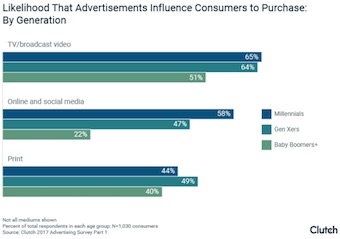Millennials exhibit some of the highest levels of trust toward advertising and are more likely to make a purchase after seeing or hearing an advertisement than older generations, according to a recent survey on consumers' views of advertising conducted by Washington, D.C.-based research and consulting firm Clutch.
The study’s findings suggest that the younger someone is, the more inclined they are to trust marketing messages. More than half of Millennials — 55 percent — polled said they trust advertising, compared to 53 percent of Generation Xers and just 44 percent of Baby Boomers. A wide majority of the 18-to-34 demographic — 81 percent — admitted that advertising influenced them to make at least one purchase in the last month, according to the survey, compared to 57 percent of Baby Boomers.
When it comes to consumers overall, traditional media seems to remain the most trustworthy source: 61 percent said they trust ads seen on TV, 58 percent said they trust print, 45 percent said they trust radio and podcasts and 42 percent said they trust public ads such as billboards and those placed in public transit. By contrast, the least trusted advertising mediums cited were online (41 percent) and social media (38 percent).
This trend doesn’t entirely map onto the Millennial generation, whose trust leans decidedly more digital: more than half of this demographic — 51 percent — admitted to trusting online and social media advertisements, compared to just 27 percent of those age 55 and older.
The survey also found that ads generally are more likely to influence Millennials to make purchases than other generations. About two-thirds of Millennials — 65 percent — said they’re likely to be influenced to purchase a product after seeing or hearing an ad on TV or via broadcast, compared to 64 percent of Gen Xers and 51 percent of Baby Boomers; and 58 percent of Millennials said seeing an online or social media ads increases the likelihood that they’ll buy that product, compared to 47 percent of Gen Xers and only 22 percent of Baby Boomers.
Gen Xers, on the other hand, were the generation most likely — 49 percent — to admit that print ads sway their purchasing decisions, compared to 44 percent of Millennials and 40 percent of Boomers.
An overwhelming majority of all respondents — 90 percent — admitted that ads influence their purchasing decisions. TV appears to remain the most effective medium, as most consumers admitted to making purchases after seeing or hearing an advertisement on television (60 percent), followed by print (45 percent), Internet (43 percent) and social media (42 percent).
The survey found those with a higher household income were slightly more likely to make a purchase after seeing or hearing an advertisement (55 percent) compared to middle (48 percent) and lower (45 percent) earning household incomes.
Clutch’s survey polled 1,030 U.S. consumers in November who reported seeing or hearing an advertisement in the past week.

 Click for full Clutch survey
Click for full Clutch survey
 Abandon traditional content plans focused on a linear buyer progression and instead embrace a consumer journey where no matter which direction they travel, they get what they need, stressed marketing pro Ashley Faus during O'Dwyer's webinar Apr. 2.
Abandon traditional content plans focused on a linear buyer progression and instead embrace a consumer journey where no matter which direction they travel, they get what they need, stressed marketing pro Ashley Faus during O'Dwyer's webinar Apr. 2. Freelance marketers and the companies that hire them are both satisfied with the current work arrangements they have and anticipate the volume of freelance opportunities to increase in the future, according to new data on the growing freelance marketing economy.
Freelance marketers and the companies that hire them are both satisfied with the current work arrangements they have and anticipate the volume of freelance opportunities to increase in the future, according to new data on the growing freelance marketing economy. Home Depot's new attempt to occupy two market positions at once will require careful positioning strategy and execution to make it work.
Home Depot's new attempt to occupy two market positions at once will require careful positioning strategy and execution to make it work. Verizon snags Peloton Interactive chief marketing officer Leslie Berland as its new CMO, effective Jan. 9. Berland succeeds Diego Scotti, who left Verizon earlier this year.
Verizon snags Peloton Interactive chief marketing officer Leslie Berland as its new CMO, effective Jan. 9. Berland succeeds Diego Scotti, who left Verizon earlier this year.  Norm de Greve, who has been CMO at CVS Health since 2015, is taking the top marketing job at General Motors, effective July 31.
Norm de Greve, who has been CMO at CVS Health since 2015, is taking the top marketing job at General Motors, effective July 31.


 Have a comment? Send it to
Have a comment? Send it to 
No comments have been submitted for this story yet.